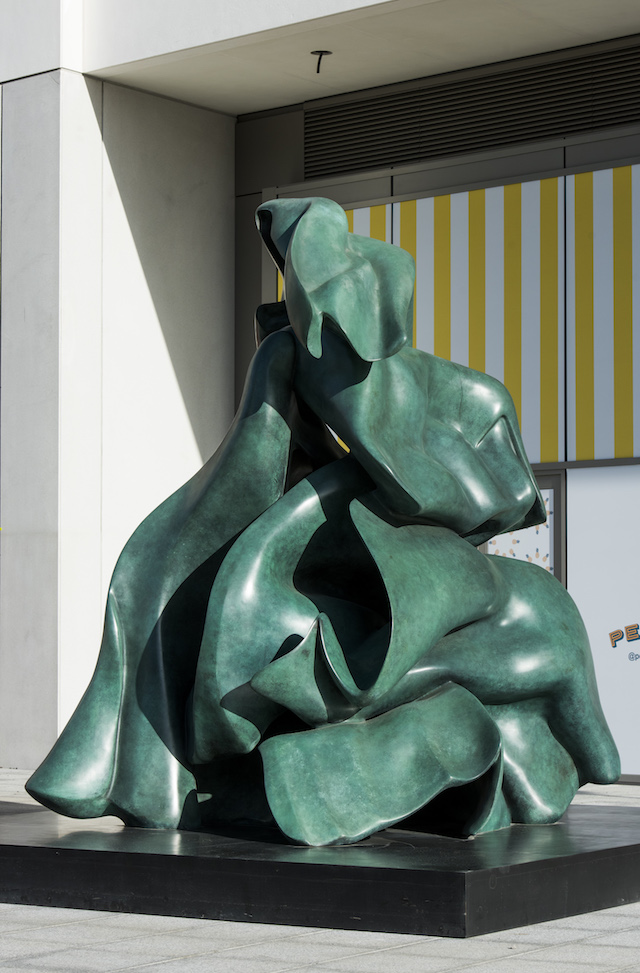Press
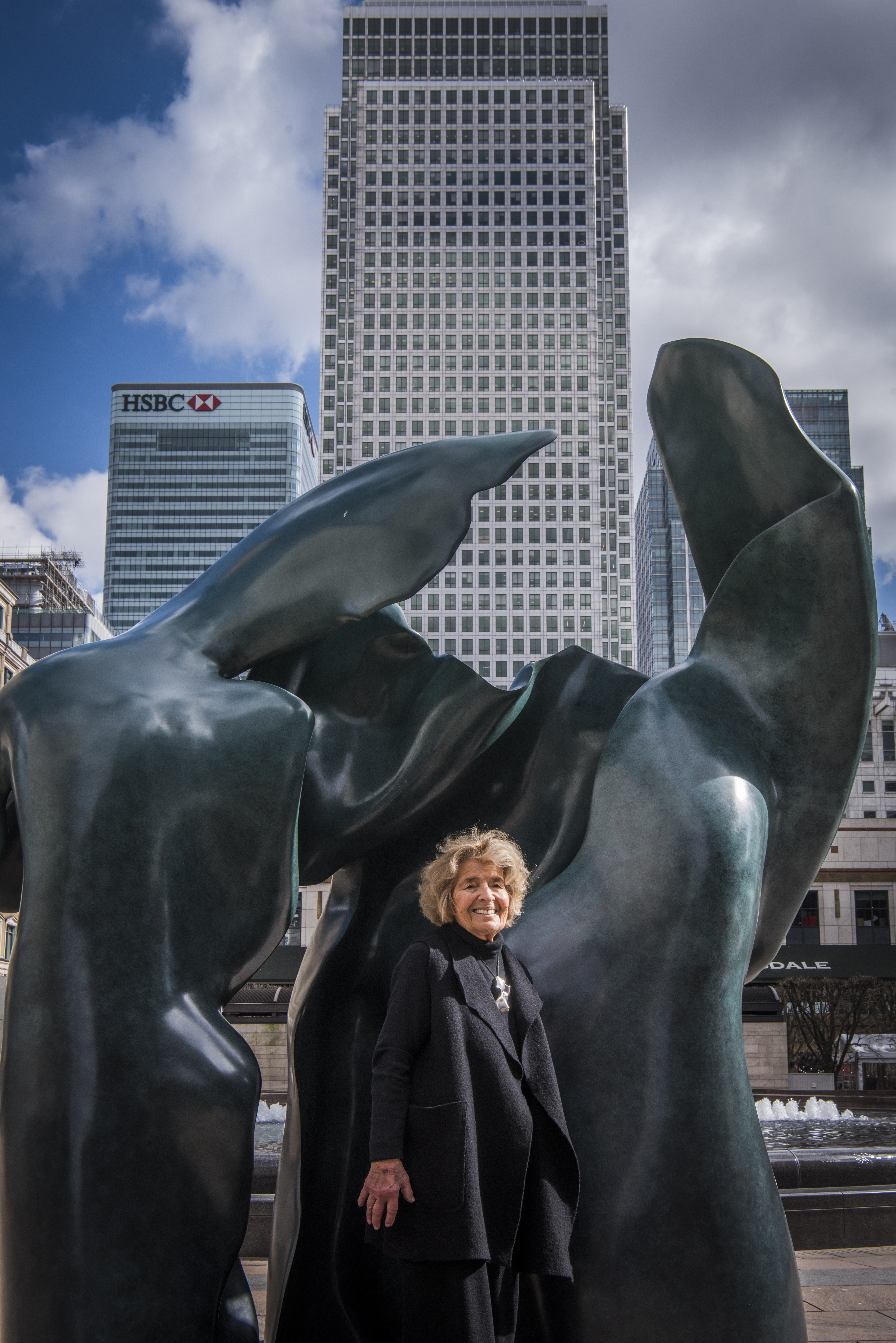 Helaine Blumenfeld with ILLUSION. Photo © Sean Pollock
Helaine Blumenfeld with ILLUSION. Photo © Sean PollockHelaine Blumenfeld: Hand in Hand
Art & Deal Magazine“My work is so… particularly because almost every piece I make has no top or bottom, side or back, and as a consequence many of them can be taken off the base and they still work. They are too multidimensional, and I don’t feel it in a drawing, you can only feel it in the dimensionality and the material.”
In his day eighteen-century German philosopher Immanuel Kant spoke of ‘the hands as the visible part of the brain’, arguing that human endeavour was determined as much by the hands as the head, and that they were capable of as much of the decision making. For English sculptor Helaine Blumenfeld her hands are the tools that out-shadow all others, as she confides, ‘in the state of creating something I barely look at it, it is all coming from deep within, my hands and my brain, my emotions, are all working together, but once I have that model, I am brutally critical.’ For Blumenfeld her hands determine everything when it comes to creating a work, often in near darkness and under layers of plastic, she appears content to let them manipulate the clay to the point of moulding an emerging form; coming at it blind. Likened to a premonition that surfaces from the soul, Blumenfeld’s soft sketches begin life entirely without her visual involvement, which comes later as she explains, when considering whether the initial form deserves pursuing as a piece. Considering how art is explained to us as a visual experience, the audience at arm’s length from the artwork, Blumenfeld sees vision somewhat differently, of a creative act that involves our sensibilities as well as our sight, going onto say, ‘My hands have been trained for so many years, to carry out what is going on within me, both within my subconscious, my visual memory, and they translate instantly, and there is just this complete connection.’ Asserting that to feel something, to reach out and touch it, is to appreciate it beyond what you see. For her audiences to become more involved with her work, in the way we do each other, Blumenfeld insists we feel for its material form, with the same desire as human contact, of the hand against the skin. In context, when given to considering that so much of modern sculpture is essentially self-contained, by virtue of the material form looking in on itself, for which the audience’s role is limited to that of a spectator. Blumenfeld sees her sculptures as points of activity, whereby the spaces within and without the works are used to evaluate one’s place and one’s relationship to the material world and how the emotional has a place in the material.
In the shadow of better-known British sculptors, Henry Moore and Barbara Hepworth, Blumenfeld has taken her sculptures into the realm of the spiritual, whereupon they are not entirely solid objects elevated on a base, but entities that by touch and the tension of emotions that Blumenfeld seeks of them, are able to transpose the physical into the ephemeral.
Sculptures that are intended to allow oneself to feel sensations that have become alien to contemporary art, which the artist would argue, comes more easily to an audience able to engage with art more freely as well as to see the work more closely, feel the skin of a sculpture by walking up to and into a work, to inhabit it, and make it one’s own. Citing how, ‘our initial learning is about how we see from touching, our hands tell us things; otherwise, we will always maintain a distance from what we are looking at, if our eyes decide everything. So, for me having people touch a form is beginning to know it in another way.’ In a sensory sense, Blumenfeld wills her audience’s hands to come into contact with her own, following the contours of her sculpture, as she originally cut them from clay, and shaped them in plaster and bronze; and that significance isn’t lost on her, of one set of hands coming close to holding another’s. That social solidarity has moved Blumenfeld immensely over the many months of social isolation and lockdown. Saying, as she sees it, ‘that in terms of ‘solace’ and of ‘unity’, and in terms of ‘love’, and my goal of having shown them on this site (at Canary Wharf ), was having previously shown at Salisbury Cathedral and Ealing Abbey, and found an audience really open to art, open to the meaning of beauty, that I never felt in museums or galleries.’
This newfound affection for her works leads us from love to beauty. Explaining how, ‘a great painting or a great sculpture, is going to have exactly the qualifications that the Greeks intended it to have and that it isn’t in the ‘eyes of the beholder,’ it is in the work, so the work is unified, it has proportion, the work has imagery, and an overwhelming sense of its own power, and all of this is in the work, it is not in our minds, and that’s why everyone should be able to appreciate great work.’ As a sculptor, Blumenfeld has an incredible sense of what translates into timeless objects, and to look at and into one of her freestanding sculptures it requires we almost we come at them as coloured mirrors, reflecting our lives back at us.
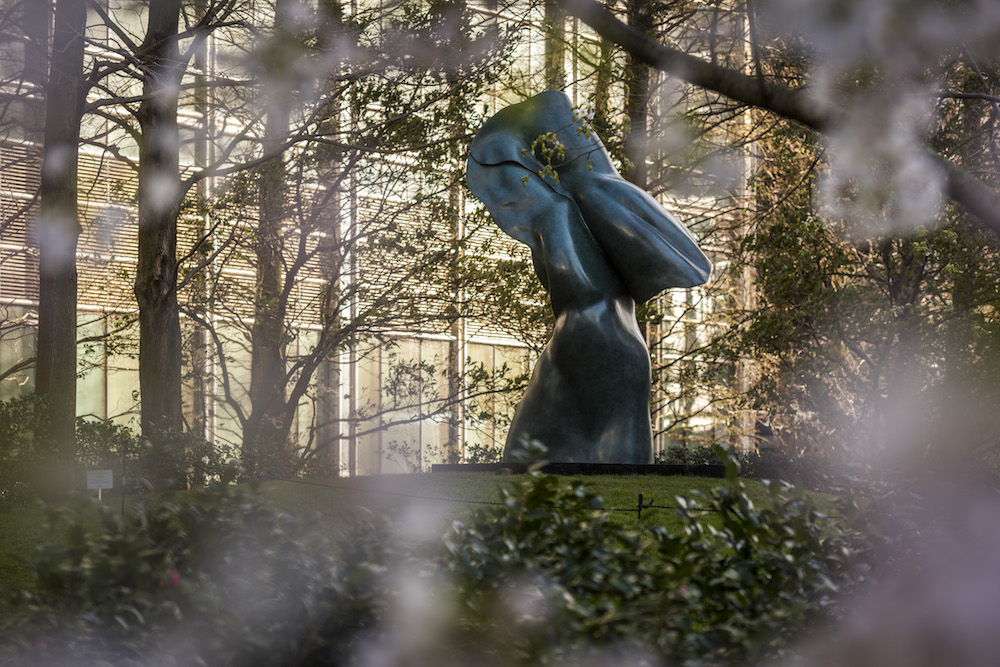
Rajesh Punj: It would be wonderful if we could begin again in a sense, now that I have had the privilege and pleasure of being with you at your home and studio, and in London for your current exhibition Looking Up. It would be interesting to talk about those works that are in-situ and outside of Canary Wharf, that are a celebration in a sense of your work to date. More specifically what proved interesting was the variables of the scale of your work, that have a certain work of a certain size, when other commands as much authority on a more intimate scale. And it is your understanding of volume, mass, and weight, contributing to the overall scale, which interests me as the critic and spectator.
Helaine Blumenfeld: What is interesting is that a lot of artists today create works on a greater scale for the sake of wanting to do something bigger. Scale is something you would think is so basic to sculpture, but I believe so many sculptors get it wrong, starting with a small maquette and thinking that it can automatically measure up. I think scale is dictated to by the original ideaand of the concept.
Early on I remember being asked by a prominent collector in this country, extremely wealthy and as famous, I won’t disclose his name but you would know him, and he loved a work of mine, a known piece called Metamorphosis, and wanted the then smaller piece seventeen times bigger. Originally a table-sized piece, he wanted it to be of an enormous scale, and I can recall saying that, ‘I wouldn’t think to do it, and that it was an intimate piece, and that there was no way that that piece could work on such a scale.’
It was interesting because the idea of enlarging that piece stayed with me, specifically in relation to that sculpture as you see it now at Wood Wharf, which is also on the cover of the accompanying catalogue. The work as you saw it outside really came out of that conversation because I was thinking of how I could take a piece like that, that was very closed in on itself, and recreate it on a larger scale. That said, I am fervently against the notion that everything that an artist does is art, I am even more against the idea that everything can be enlarged into a monumental one. Very few can, very few have the ‘power’, the ‘strength’, the ‘nobility’ or the ‘stature’ to grow into greater works. I put a lot of energy and effort into the pieces that ‘can’ be enlarged, and as you saw from the exhibition, very often they began life as clay models that led to their sister works on a larger scale. But in principle, I would never go blind from two feet to eight or ten feet. I will enlarge a maquette and see if it can sustain that size, of a work going from seven to twelve feet, but if I can already see that it isn’t going to work, I will destroy the model because it can be that it won’t even work at seven feet.
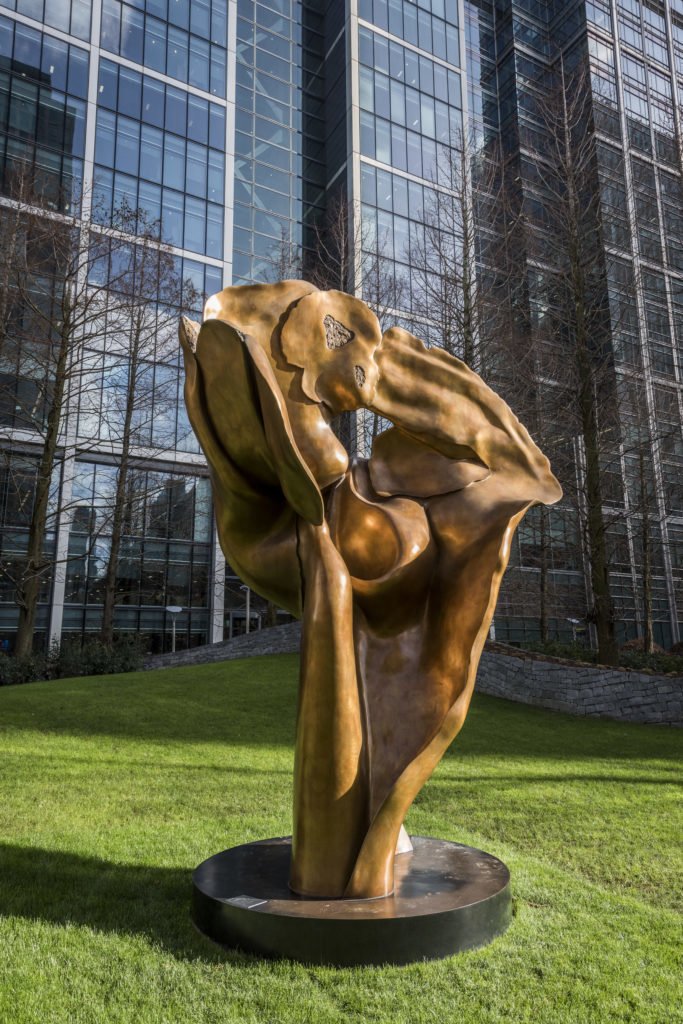
RP: And how has that come about, that sense of scale that you have about you, and of the intuitive act of understanding what will and won’t be able to ‘grow’, as you put it so brilliantly, into a larger work?
HB: I suppose it must be intuitive, and as well it must have come from having done a lot of work, and my trying works of varying scales, and seeing that only an exceptional piece will take to that scale, and be able to occupy and own the space. Even, and I am reluctant to criticise other sculptors, Henry Moore whom I knew, very often his sculptures look like models that were enlarged because, in the process of enlargement, the piece literally has to grow. To add to its base, as well as to the top of it, so the work becomes elongated, because, and it’s a question of perspective from standing below it and looking up, you will come into contact with elements of it. In the case of Metamorphosis, the top part of it, which appears like a crown, when I saw the assistants working on the final model before we were carving and casting the original mould, I said ‘no, that’s too small, we have got to do it larger’ because as you looked up at it, it appeared much less of a form, and it didn’t hold the rest of the sculpture the way that I wanted it to. So, and this is something I remember you and I talking about before, that in the state of creating something I often barely look at it, it is all coming from deep within me, my hands and my brain, my emotions, are all working together; but once I have that model, I am brutally critical. Then an aspect of my own aesthetic comes into it. I will look and evaluate it. I won’t judge a work when it is in a finished state because I think if you do that you can ruin a piece and you can take away the whole splendour of spontaneity.
The moment you decide it is finished you have got to get outside of it. It is no longer within you but outside of you. I have got to see it in its three-dimensional state, without any intervention from my emotions in a way, and at that moment it becomes fiercely intellectual, and that judgement never failed me, and I can say that this part of a sculpture is going to work longer, or that it has to be shorter. Or I could say this piece isn’t good, and the number of pieces I reject is just phenomenal.
During lockdown I have done twenty-seven, no more, thirty new pieces, and the last six are still in clay, the others in plaster. I properly shouldn’t say thirty-six, I probably did fifty and chose thirty-six, and now with the last six, I am not sure if any of them are any good. Even then I still see them all as studies that will lead me to the next stage. My husband has said they are wonderful, but something in me says ‘yes, but they don’t work’, (and I immediately see them as) ‘transition pieces’ leading onto something else. It is so hard to convert things into plaster, because the man I use lives in Oxford, and we have to get (the smaller works) to him, when before I was doing it at my studio in Italy, and my assistant and I would make those decisions in plaster. So, it becomes more of a question of whether it is this worth all that effort? Or is it something that is going to be replaced by something else?
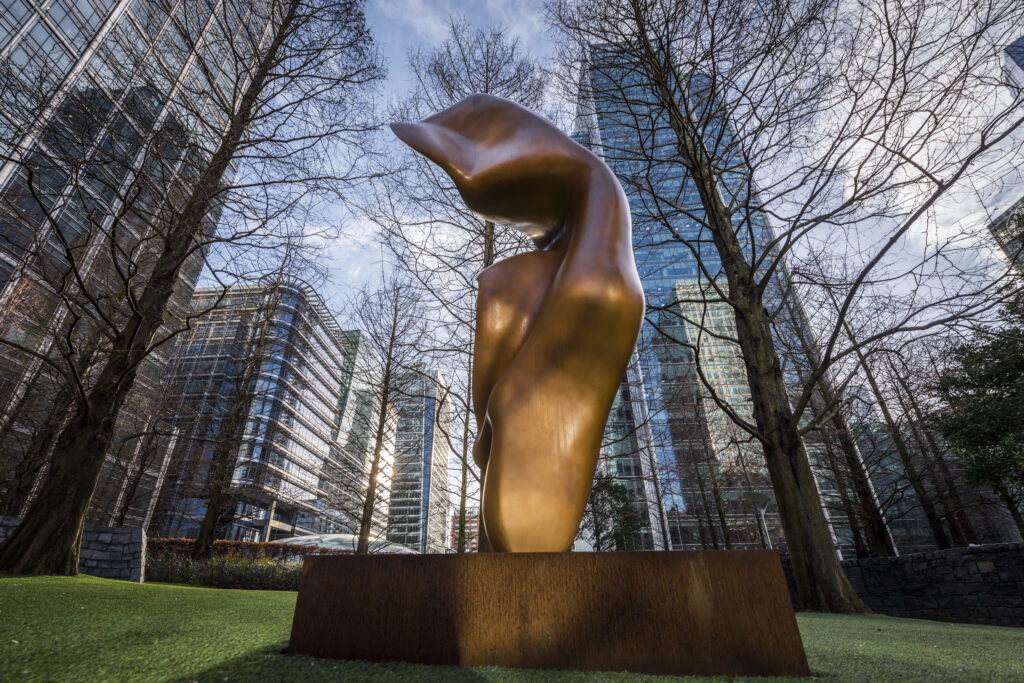
RP: In terms of those opposing forces of creation and destruction, as you see it, do you think that destroying works is more important than keeping them as visual references?
HB: I will always destroy those particular works that don’t work if they are in clay, but if I go as far as to get them into plaster, I keep them. Left clay will self-destruct after a while.
RP: Do you manage to memorise the forms of those original works, if you have no evidence of them?
HB: That is such a good question.
RP: The lost works, as you say, become part of your progression?
HB: Very early on I had my first big show in Soho, New York, in 1976, when it was just becoming the place for galleries. I wanted one more work, and at the time I was creating works that appeared as multiples, the first of those kinds of works, and I had a sculpture in four parts that I wanted to have in marble. I remember I had it in clay and I had organised the marble and placed each piece the way I wanted it to be in the marble, and I left two of my assistants to begin ‘roughing out’ the initial sculpture. I was coming back in two weeks to work on it, and I received a phone call saying, ‘Helaine we don’t know how to tell you this’, and I said, ‘Well you better just tell me!’ Well they had left the clay pieces, it was a glorious day, they were being worked on, and when they came back to them it was after a sudden storm, and instead of clay models they had dissolved into pools of clay, with nothing of the original work left.
So, what I did was go into the studio and start all over again, and it was as if I had a complete trace of everything I had done already, but now I was able to take it one step further. So, the new work was so much better than the one that had disappeared. I bought them to back to life but wasn’t able to transfer them to plaster, which would have taken too many additional days. Instead, we completed the work in clay. But I think it is actually true, and that’s where the progress comes from, from all of those mistakes, because it is just like writing a novel, and carrying those words with you, that even if you lose the original transcribe, you can likely write it again. Granted it will be different but it will probably be better because you have had time to process and approve it.
RP: Allowed it to mature. So, are you not sketching and drawing forms in charcoal and pencil, as the possible outlines or boundaries of your sculptures?
HB: I did in the beginning but not now, my work is so… particularly because almost every piece I make has no top or bottom, side or back, and as a consequence many of them can be taken off the base and they still work. They are too multi-dimensional, and I don’t feel it in a drawing, you can only feel it in the dimensionality and the material.
RP: Is it that your hands, and I believe we did previously touch on this, serve as your antenna for the shape of the initial form?
HB: Yes, some years ago the fellows at the Royal Society of Sculpture gave a talk, three different speakers, of what their most important tools were when working, and for me, no question, the only thing I could not do without are my hands, because my hands are attached to me, and they have trained for so many years, to carry out what is going on within me, both within my subconscious and of my visual memory. They can translate instantly, and there is just this complete connection. I don’t even need light when working some of the time because it is a matter of feeling for the shape and the form.
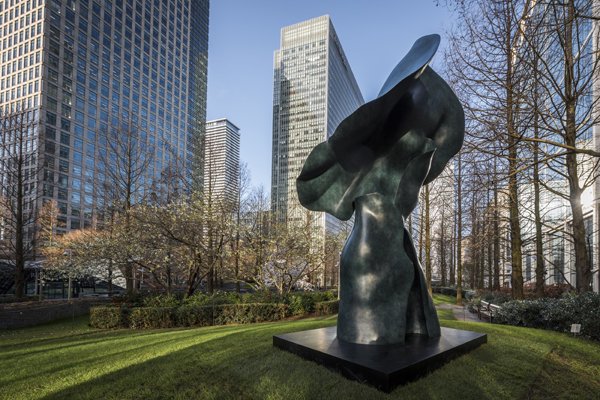
RP: Does there feel a kind of disconnect of your hands from your head in that sense?
HB: There is, as you say, such a disconnect that when I am working in Italy if I am at that stage where I am not looking because I insist on not looking too soon, I will cover the model over with several layers of wet cloth and plastic, and when I come back late in the evening I will come into my studio, and if my life depended on it, I couldn’t tell you what I would find under that temporary packing. I couldn’t, I have no idea, and when I open it up it can be a shock. Seeing it then is the moment of total truth, because I am looking at it without any excuses. I will see it and say ‘wow, that is incredible’, or I will say ‘what did I have in mind?’ and ‘where is this leading?’
RP: So, in that sense do you consider your hands as having their own visual sensitivity, or their own way of seeing, and that your eyes introduce a different kind of scrutiny – of the heart and the head combing if you like?
HB: I feel as if I have two kinds of vision, there is the inner vision that drives me to begin with, and then I have the critical that it is not about a work of art, and can never be; and it is something that has interested me a lot.
